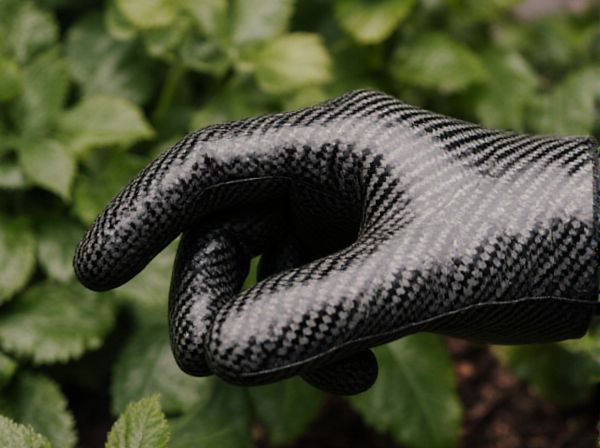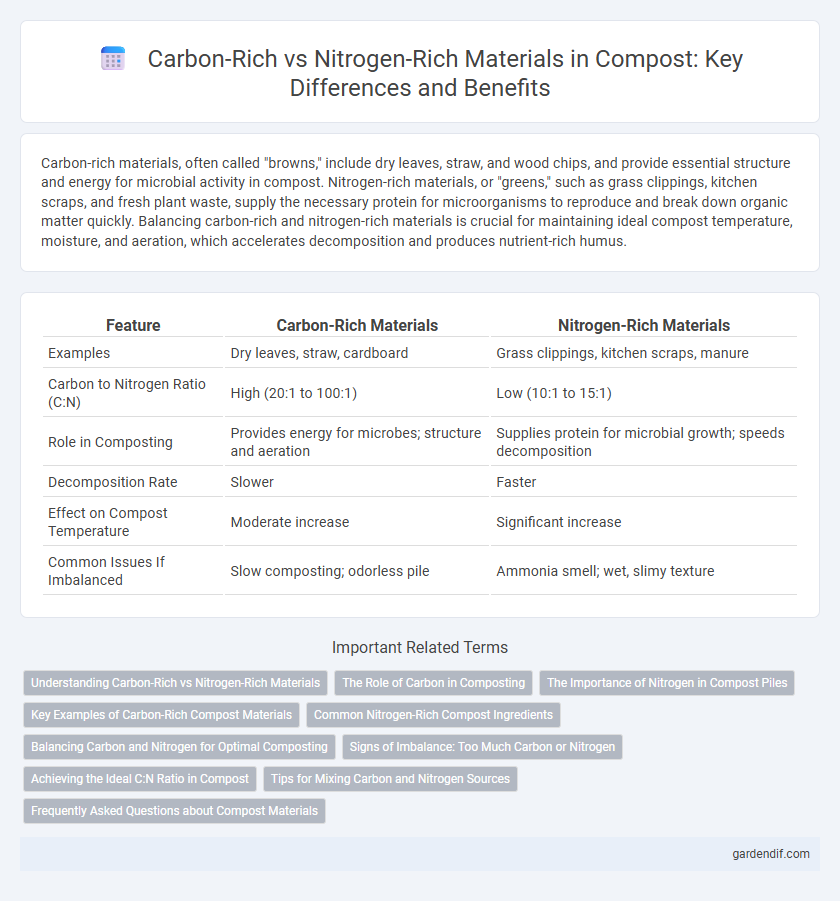
Carbon-rich materials vs Nitrogen-rich materials Illustration
Carbon-rich materials, often called "browns," include dry leaves, straw, and wood chips, and provide essential structure and energy for microbial activity in compost. Nitrogen-rich materials, or "greens," such as grass clippings, kitchen scraps, and fresh plant waste, supply the necessary protein for microorganisms to reproduce and break down organic matter quickly. Balancing carbon-rich and nitrogen-rich materials is crucial for maintaining ideal compost temperature, moisture, and aeration, which accelerates decomposition and produces nutrient-rich humus.
Table of Comparison
| Feature | Carbon-Rich Materials | Nitrogen-Rich Materials |
|---|---|---|
| Examples | Dry leaves, straw, cardboard | Grass clippings, kitchen scraps, manure |
| Carbon to Nitrogen Ratio (C:N) | High (20:1 to 100:1) | Low (10:1 to 15:1) |
| Role in Composting | Provides energy for microbes; structure and aeration | Supplies protein for microbial growth; speeds decomposition |
| Decomposition Rate | Slower | Faster |
| Effect on Compost Temperature | Moderate increase | Significant increase |
| Common Issues If Imbalanced | Slow composting; odorless pile | Ammonia smell; wet, slimy texture |
Understanding Carbon-Rich vs Nitrogen-Rich Materials
Carbon-rich materials, also known as "browns," include dry leaves, straw, and wood chips, providing essential carbon that fuels microbial energy in composting. Nitrogen-rich materials, or "greens," such as grass clippings, food scraps, and coffee grounds, supply the nitrogen necessary for protein synthesis and microbial growth. Maintaining an optimal carbon-to-nitrogen (C:N) ratio, typically around 30:1, enhances decomposition efficiency and reduces odor in compost piles.
The Role of Carbon in Composting
Carbon-rich materials, such as dried leaves, straw, and cardboard, serve as essential energy sources for microorganisms during composting by providing the structure needed for microbial respiration. These materials balance the carbon-to-nitrogen (C:N) ratio, typically ideal around 30:1, to optimize microbial activity and accelerate organic matter decomposition. Proper carbon content prevents odors and excessive nitrogen loss, ensuring efficient compost maturation and nutrient-rich humus formation.
The Importance of Nitrogen in Compost Piles
Nitrogen-rich materials, such as grass clippings, kitchen scraps, and manure, play a vital role in compost piles by accelerating microbial activity and facilitating the breakdown of organic matter. These materials balance carbon-rich components like dried leaves and straw, ensuring an optimal carbon-to-nitrogen ratio of approximately 30:1 for efficient decomposition. Adequate nitrogen availability enhances heat production within the pile, promoting faster compost maturation and reducing the risk of unpleasant odors.
Key Examples of Carbon-Rich Compost Materials
Key examples of carbon-rich compost materials include dry leaves, straw, wood chips, and shredded paper, which provide essential carbon to balance nitrogen levels in compost piles. These materials are crucial for creating a healthy compost environment by promoting microbial activity and preventing foul odors. Properly combining carbon-rich substances with nitrogen-rich materials like grass clippings and food scraps ensures efficient decomposition and nutrient-rich compost.
Common Nitrogen-Rich Compost Ingredients
Common nitrogen-rich compost ingredients include kitchen scraps such as vegetable peels, coffee grounds, and fresh grass clippings, which provide essential proteins and enzymes for microbial activity. Manure from herbivorous animals like cows, horses, and chickens is a highly effective nitrogen source that accelerates decomposition. These materials balance carbon-rich sources such as dried leaves or straw, ensuring optimal nitrogen-to-carbon ratios for efficient composting.
Balancing Carbon and Nitrogen for Optimal Composting
Balancing carbon-rich materials such as dried leaves, straw, and wood chips with nitrogen-rich materials like grass clippings, kitchen scraps, and manure is essential for efficient composting. A carbon-to-nitrogen (C:N) ratio of approximately 30:1 ensures optimal microbial activity, accelerating decomposition and minimizing odors. Maintaining this balance prevents compost pile overheating or slow breakdown, resulting in nutrient-rich, well-aerated compost.
Signs of Imbalance: Too Much Carbon or Nitrogen
Excess carbon in compost often results in slow decomposition and dry, woody materials that resist breakdown, while too much nitrogen causes a strong ammonia odor and overly wet, slimy layers. Ideal compost balances a carbon-to-nitrogen ratio around 30:1, crucial for efficient microbial activity and odor control. Signs of imbalance include slow composting with dry textures for excess carbon and foul smells with potential fly infestations indicating excess nitrogen.
Achieving the Ideal C:N Ratio in Compost
Carbon-rich materials, such as dry leaves, straw, and wood chips, provide the bulk and energy needed for microbial activity in compost. Nitrogen-rich materials, including grass clippings, kitchen scraps, and manure, supply essential proteins and support rapid microbial growth. Achieving the ideal carbon to nitrogen (C:N) ratio of approximately 30:1 maximizes decomposition efficiency and produces nutrient-rich, balanced compost.
Tips for Mixing Carbon and Nitrogen Sources
Balancing carbon-rich materials like dried leaves, straw, and wood chips with nitrogen-rich materials such as grass clippings, kitchen scraps, and green plants is essential for effective composting. Aim for a carbon-to-nitrogen ratio of about 30:1 to optimize microbial activity, avoid odors, and speed up decomposition. Regularly alternating layers of browns (carbon) and greens (nitrogen) while maintaining moisture ensures proper aeration and nutrient breakdown in the compost pile.
Frequently Asked Questions about Compost Materials
Carbon-rich materials, often called browns, include dry leaves, straw, and cardboard, providing essential energy for microorganisms in compost. Nitrogen-rich materials, or greens, such as vegetable scraps, grass clippings, and coffee grounds, supply proteins that drive microbial reproduction and decomposition. Balancing carbon-to-nitrogen ratios around 25-30:1 ensures efficient composting by optimizing microbial activity and minimizing odors.
Carbon-rich materials vs Nitrogen-rich materials Infographic

 gardendif.com
gardendif.com